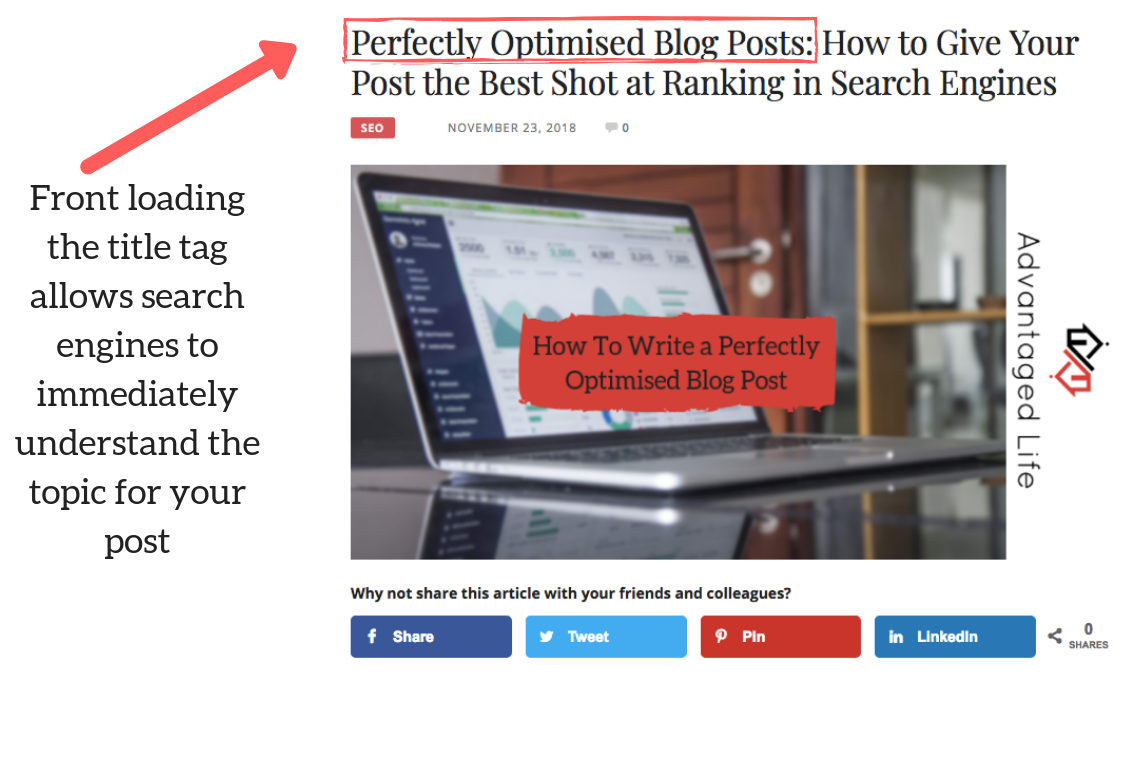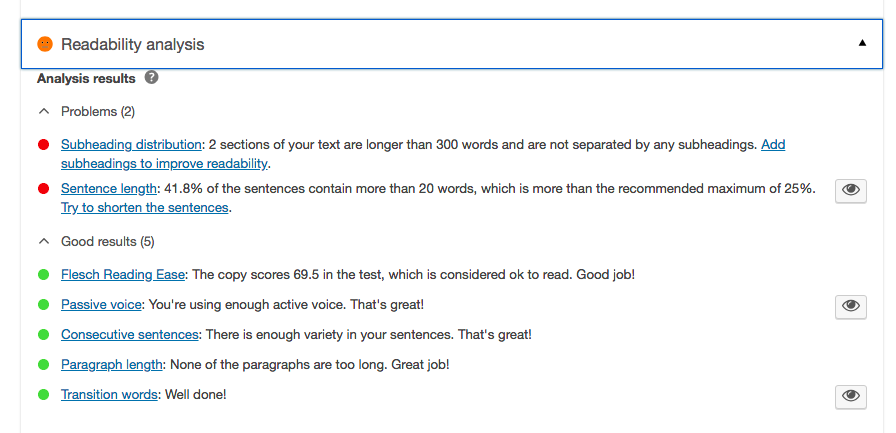Gone are the days when you could succeed in ranking websites with keyword stuffing and aggressive link building. Google has evolved both its on-page and off-page algorithms and its time you stepped up your game too. A perfectly optimised blog post requires a little extra effort but you can reap some large rewards by nailing your on-page SEO.
In this short guide we are going to look at what a perfectly optimised blog post looks like so that before you even think about building links to it, you’ve set yourself up on a very solid foundation.
Title Tags, Header Tags & Meta Descriptions
Starting with optimisation of your title of your post or page itself, you need to correctly optimise your title tag first. This is most important on-page SEO factor as it is what Google reads first for your chosen keyword. Bearing this is in mind, it is crucial to place your focus keyword at the start of the title so it has the most weight it possibly can.
To illustrate the point further look at my title tag below. Can you see how I have front-loaded it?
 It’s like I am jumping up and down and screaming at Google, “HEY THIS POST IS ABOUT PERFECTLY OPTIMISED BLOG POSTS!”
It’s like I am jumping up and down and screaming at Google, “HEY THIS POST IS ABOUT PERFECTLY OPTIMISED BLOG POSTS!”
You can then (if you wish) optimise even further by adding words like “best”, “guide” or “review” because it will help you rank for long-tail versions of your keyword and help rank for similar semantic search queries.
Next are header tags. You should place a header 1 (H1) tag around your title (WordPress does this automatically), followed by header 2 (H2) tags around your subheadings so Google’s bots can quickly crawl your article and learn what it is about.
You should only try to use one H1 tag ideally (because it’s by far the most important) and then you can use multiple H2 and H3 tags, all the way down to H6 for the rest of your subheadings. If you use multiple H1’s you are likely to confuse search engine crawlers if they are completely different in nature.
You wouldn’t want one H1 tag saying “Best car mechanic tool kits” another saying “best cheese factories to visit”. You’ll leave search engines clueless.
So just stick to one if possible and make the topic clear immediately. If you feel you have to use more than one (you should never “have to”) then make it related. In the example above this would be something like “best toolkits for mechanics”.
Here’s what Google had to say recently on the issue of having multiple H1’s:
Even though they say it’s ok, I would still advise only using one and making it as clear as day what the topic is.
It is up for debate how important headers 4 and above are so it makes sense to reuse H2 and H3 tags for important keywords in your other headings.
Finally, whilst SERP titles and meta descriptions do not count as a ranking factor per se, they are still crucial as they are your chance to tell potential visitors what your site is about. If you manage to write an enticing and compelling meta description, you will see your click through rate soar, which will boost you up the rankings.
Items that increase click through rates include: adding brackets to your titles (don’t know why this works but…wait a minute…see what I’ve done here?!), adding words like “today”, “now”, or “this weekend” to add urgency to your posts, apparently odd numbers work better for listicles, and finally modifiers like “2019”, “Checklist”, “Ultimate Guide” etc. help to increase click through rates.
I’ve included an excellent example below:

Ok I lied. This could be improved slightly, it needs the name of the website in the title for branding purposes.

Optimise Your On-Page Text
Next, you need to go in and optimise the text of the post itself. Firstly, make sure you write as much as you possibly can. Long-form content of more than 1500 words consistently outranks shorter content, if you can write 4,000 words on a topic (without boring your reader to death) then do it.
Secondly, make sure to include two types of links in your writing. One set of internal links should be focused on taking visitors to another page on your website, which keeps them on your website for longer and dramatically decreases bounce rates.
The second set of links should be out to other similar websites in your niche. These outbound links give Google a relevancy signal so it knows which subjects it should be ranking your site for. If you are creating a blog or website about cars linking out to a page about pet insurance will confuse the hell out of Google. Keep your outbound links on topic.
Throughout your text make sure to sprinkle Latent Semantic Indexing Keywords. These LSI keywords should be made up of synonyms and related search queries.
As Google search becomes less about exact keywords and more about semantics it’s crucial that you include some of these keywords in your writing. For example, Google’s algorithm has got to the stage of recognising that “WordPress Classes” is the same as “WordPress Courses” and other similar synonyms.
There is a really easy method to find them for your posts. Simply type in your keyword in Google and scroll to the bottom for related searches.

There you go, it’s as simple and easy as that, there’s 8 LSI keywords straight off the bat, and no need for fancy software either!
Damn. I really need to insert some of those words into this post.
The final, and one of the most important, steps to writing SEO friendly blog posts (<<< nicely done Joe…no-one will notice) is inserting your keyword in the first 100 words of your text.
You need to let Google (and other search engines) know immediately what your article is about, if their bots can match your H1 tag exactly with a phrase in the first paragraph of your post then it knows what your post is about and can place it in its own index accordingly.
Make Use of Video and Images
If you are presenting readers with just solid blocks of text, then it is likely that you will observe high bounce rates and low dwell time. In order to perform well in Google’s on-page performance criteria you need to provide at least 2-3 images.
Make sure to add your focus keyword in the “Alt Text” box when adding them to the site, and for ultra-optimisation you can name the actual filename of your image the keyword (e.g. your_keyword.jpeg).
This means even if you picture is of a man parachute skiing off the coast of Barbados and your post is about “Ketogenic Diet Tips” you name the file Ketogenic_Diet_Tips.jpeg
This just makes everything neat and tidy, and Google really likes neat and tidy.
Video enhances performance even better. If you can embed a YouTube video into your page or post you can see dwell times rocket to several minutes which will zoom you up the rankings. If you can go one step further and produce your own video content, you will send all of the right signals to Google.
It’s also useful to remember that YouTube is owned by Google, so it is likely to give that platform preference over other video uploading sites such as Vimeo (though they’ll never confirm this).
Short URL Structure
Once you’ve done all of the above it’s time to step back for a hot second and take a wider look at your blog. You need to make sure your URL structure is as simple and to the point as possible. Google will find it difficult to assess the topic if your URL looks anything like this:
yourwebsite.com/10/2019/category/page/1/yourkeyword
Instead optimise so it is no more than one or two stems away from your root domain:
Yourwebsite.com/yourkeyword
Yourwebsite.com/category/yourkeyword
This will leave Google in no doubt about what your keyword topic is and it will help to provide relevance to search engines about your categories.
Enable Social Sharing
So you’ve written your perfectly optimised blog post, if only there was some way people could share your amazing content…oh wait there is…
Social sharing buttons!
Just add these little babies to your blog post so people can share your post far and wide which helps Google to recognise it’s a post people are talking about.
Opinion is split on how important social signals to a website are, but I am a big fan of them, I have always seen ranking increases after a post has been shared around on social media.
So just download one of the free social media sharing button plugins (I use Social Pug) and just activate it to allow people to spread your awesome content far and wide.
Use Yoast SEO Plugin as a Reminder Tool
If you ever forget all of these handy tips that I have laid out for you I find the Yoast SEO Plugin really user friendly and easy to use.
It will present you with a checklist using its traffic light system and will let you know anything that you have forgotten to do.
However, no plugin is perfect and there are a few things you need to ignore on their checklists. Firstly, ignore the keyword density. It will say something along the lines of “we found the keyword 5 times; this is too low as it only accounts for 0.4% of the text”.
As I have laid out above, Google no longer works in this way, it uses the semantic search as the basis for understanding a page. As long as the crawl bots can find a lot of related terms (LSI keywords) throughout your text, you will be fine.
In fact, if keyword density was an issue, then keyword stuffing your post to rank would still work.
But it doesn’t.
In fact, is hasn’t for over 10 years.
To the Yoast guys and gals, if you are reading this, please ditch this from your checklist!
I’m not saying don’t use your keyword when you have the opportunity, I’m just saying don’t worry about having to cram it in 10 times in a 1,500-word post. 2-3 times per 1,000 words is more than enough as long as you sprinkle in some relevant LSI keywords.
Finally, just ignore the readability function of this plugin. It has no use to anyone whatsoever, I’m sure every single one of my posts is marked as red on their system but they do just fine.

Apparently this post scores 69.5 on the Flesch Reading Ease Test…

Yep, I’m as clueless as to what this means as you are.
So just ignore it, for the sake of your own sanity.
Conclusion
So there you have it, systematically complete all of these tasks and you’ll end up having a perfectly optimised blog post (or page) for on-page SEO purposes. In terms of optimising your website generally, just make sure your theme is mobile responsive and the steps above will take care of the rest. Good luck!
If you enjoyed reading this you may want to take a look at my Beginners Guide to SEO so you can familiarise yourself with the three key tenets of search engine optimisation.
